Abstract
The relationship between hypersensitivity and cellular resistance to infection with facultative intracellular parasites was studied in mice by using infection-immunity in tularemia as a model system. Delayed hypersensitivity to antigenic fractions of Francisella tularensis was first detected 6 to 7 days after immunization with viable F. tularensis vaccine, at which time immunity against challenge infection developed. Both immunity and delayed-type sensitivity reached maximal levels by 9 to 10 days. Immediate hypersensitivity occurred after immunization with both viable and nonviable tularemia vaccines but could not be correlated with resistance since nonviable antigens were not protective. Attempts to relate resistance to F. tularensis with nonspecific immunity factors were unsuccessful. Immunization of mice with BCG vaccine stimulated protection against infection with F. novicida and Salmonella typhimurium but provided no protection against infection with F. tularensis. Moreover, viable tularemia vaccine, while inducing marked protection against challenge with specific organisms, afforded no protection against infection with S. typhimurium or S. enteritidis. It is concluded that cellular immunity in tularemia involves an immunologically specific component.
Full text
PDF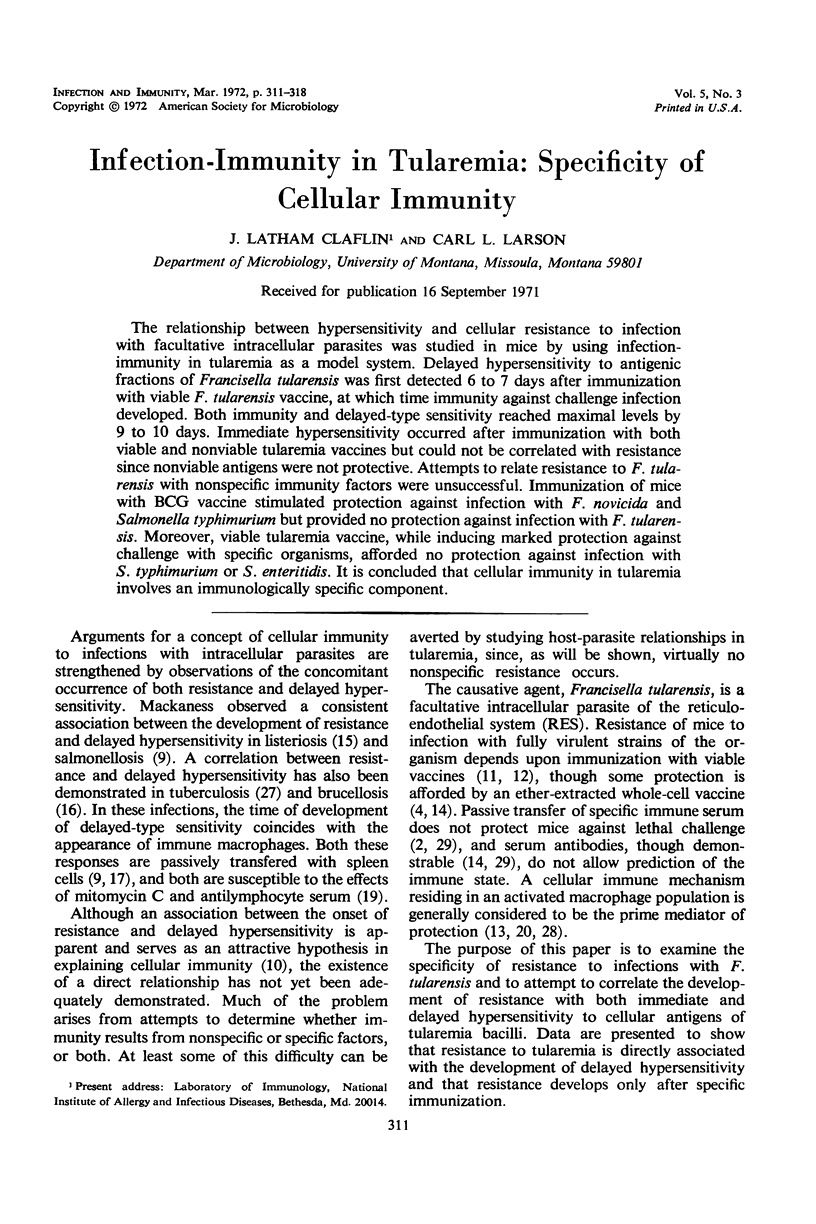
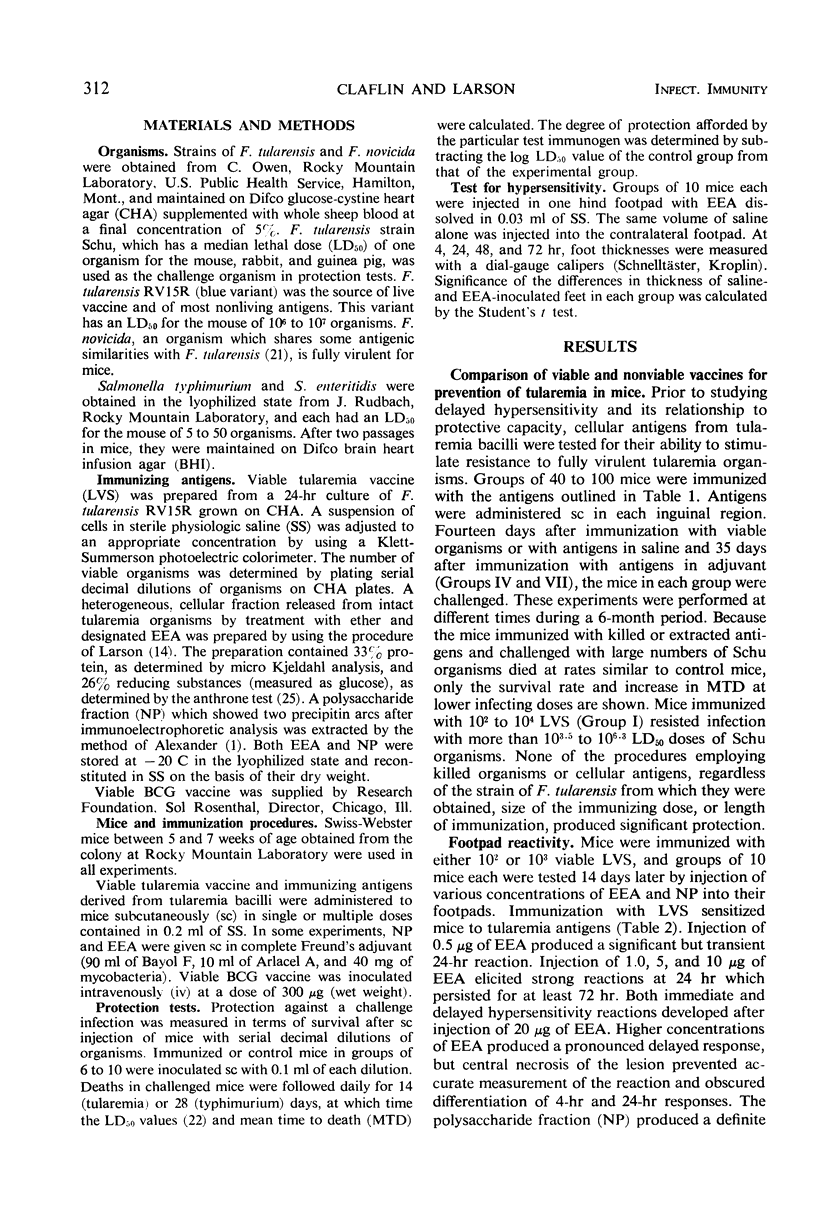
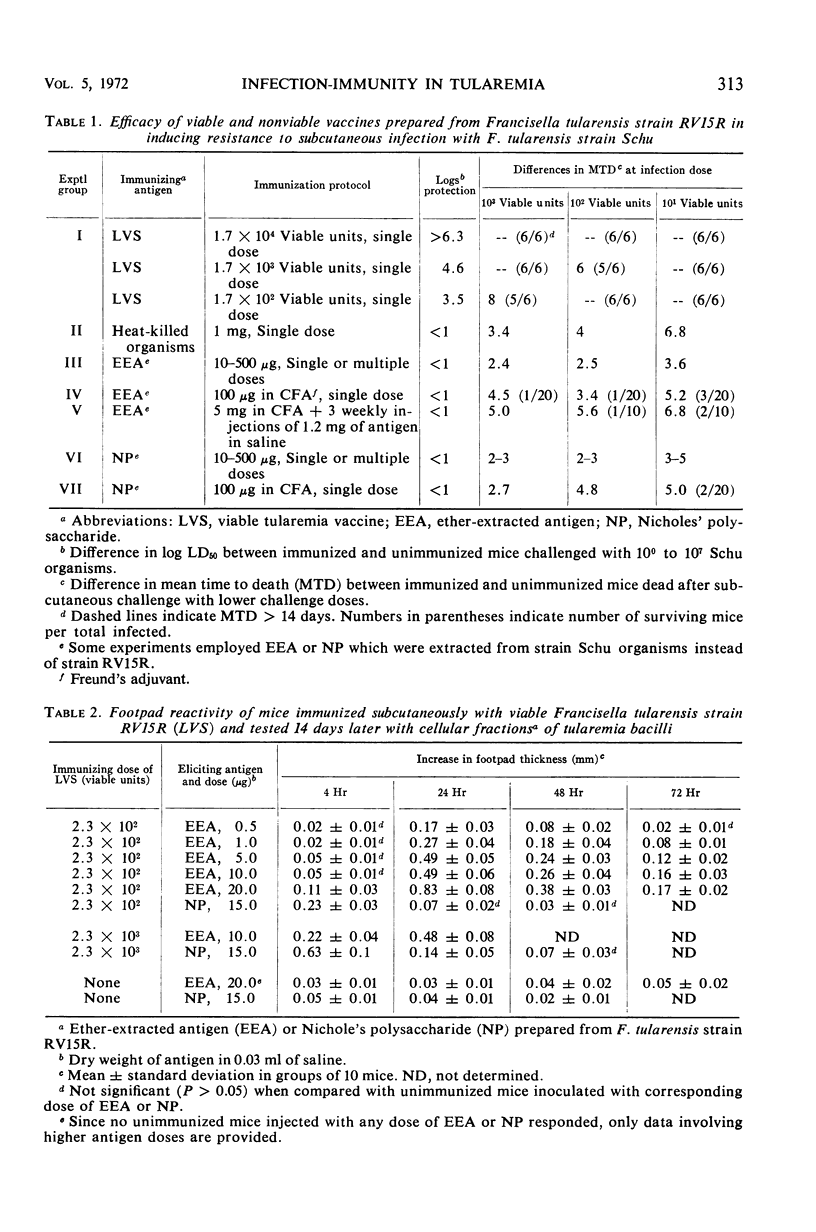
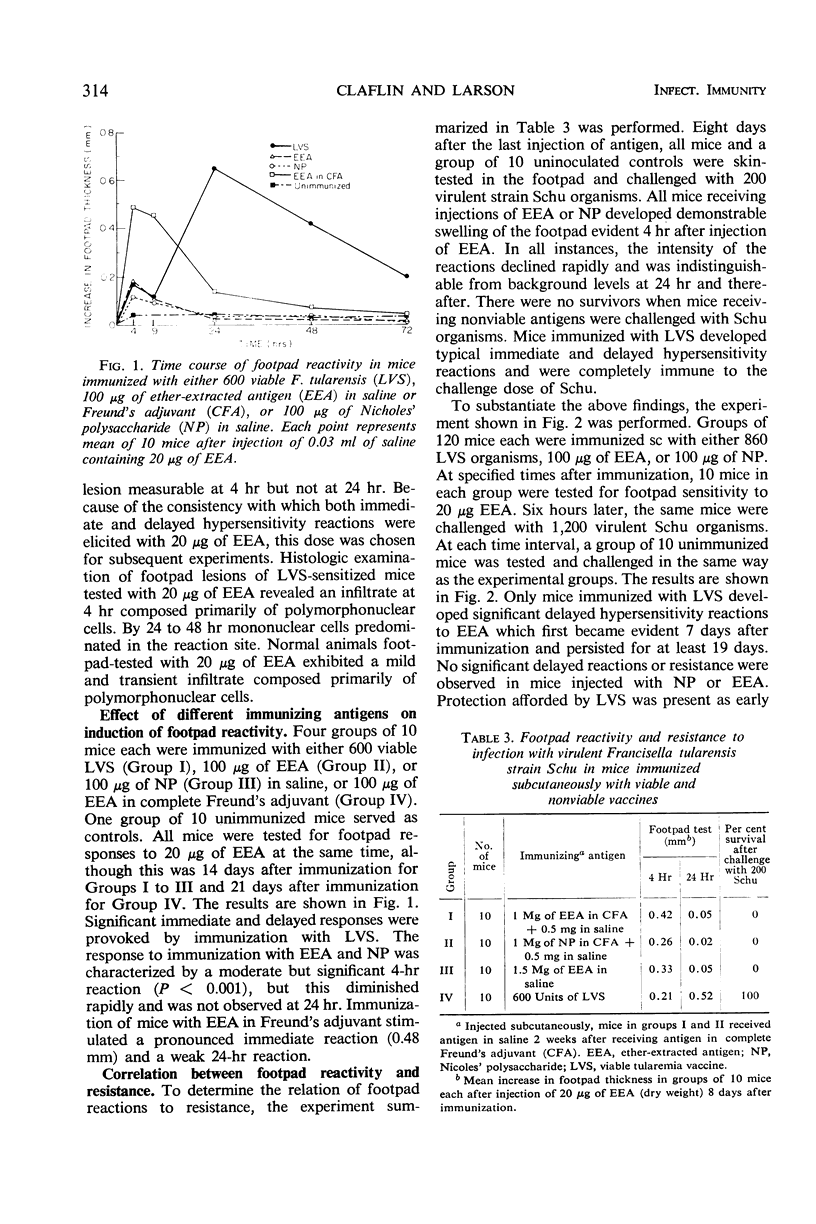
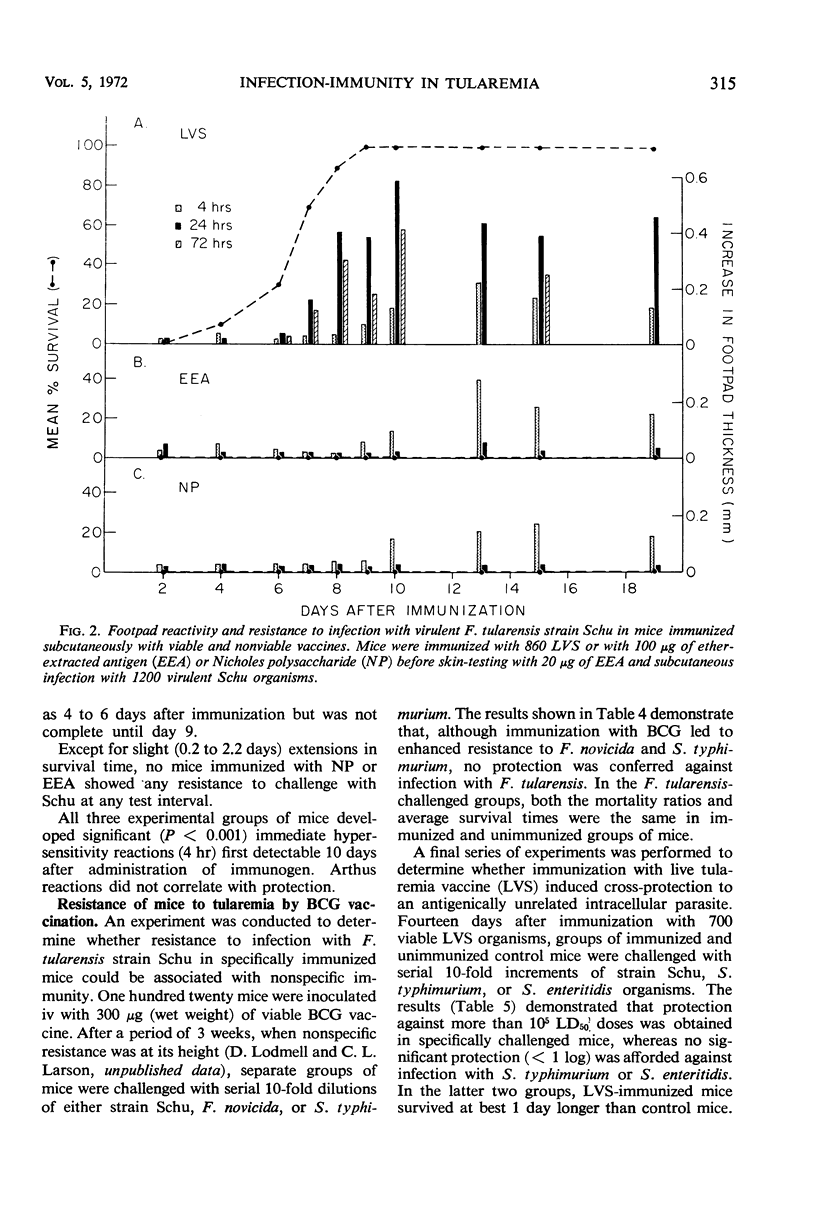
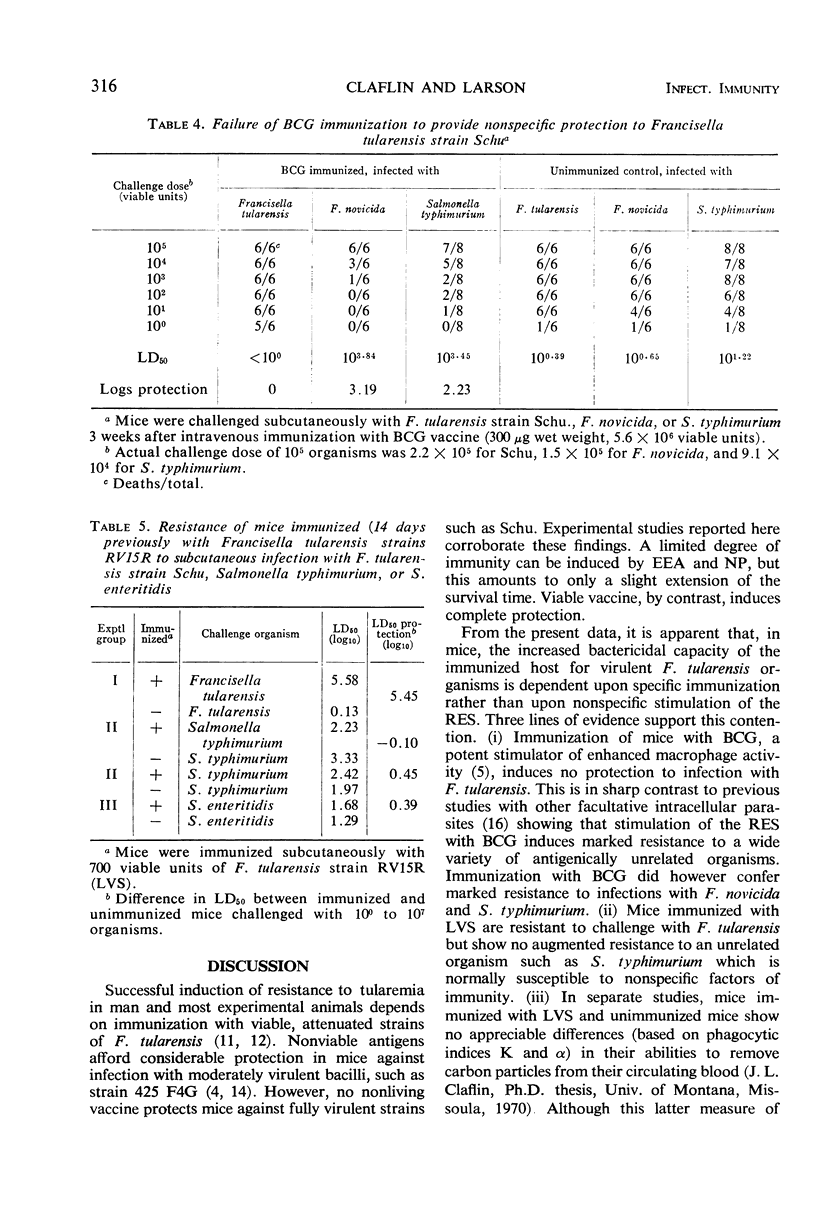
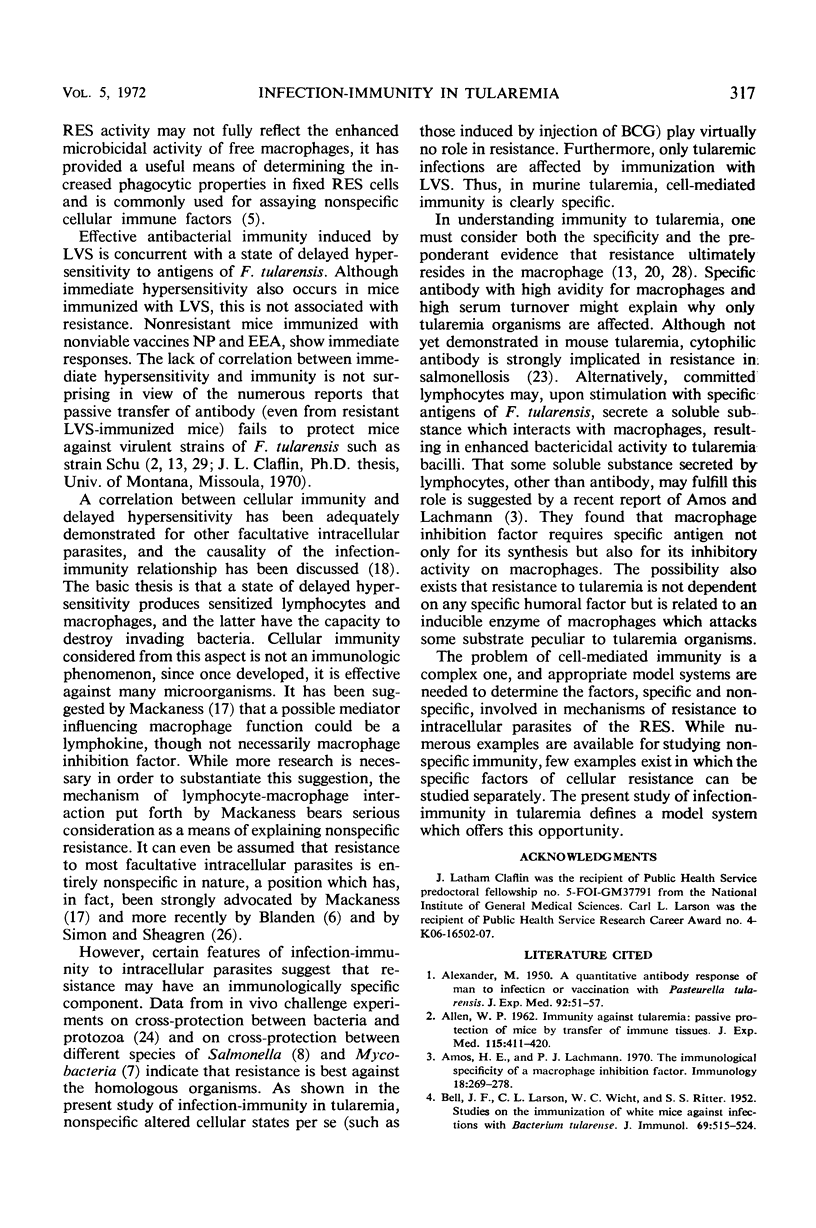
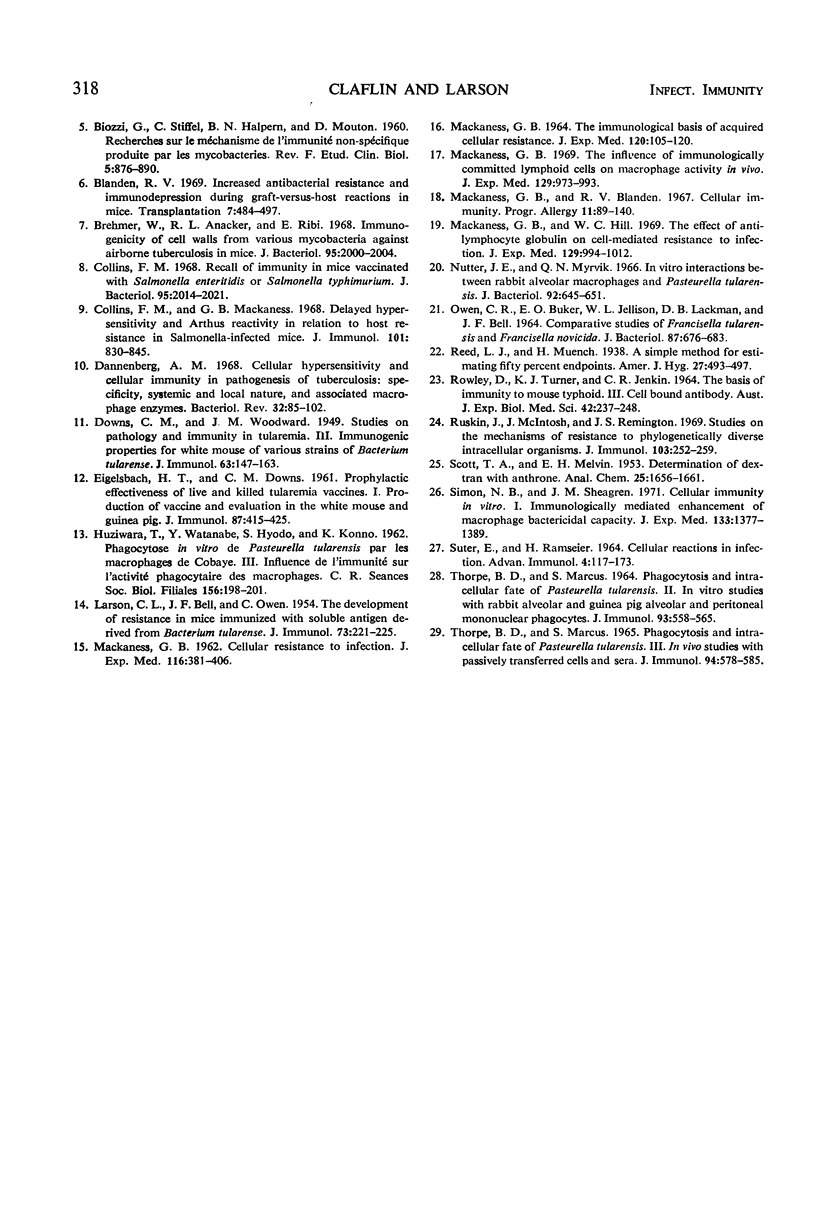
Selected References
These references are in PubMed. This may not be the complete list of references from this article.
- ALEXANDER M. M. A quantitative antibody response of man to infection or vaccination with Pasteurella tularensis. J Exp Med. 1950 Jul 1;92(1):51–57. doi: 10.1084/jem.92.1.51. [DOI] [PMC free article] [PubMed] [Google Scholar]
- ALLEN W. P. Immunity against tularemia: passive protection of mice by transfer of immune tissues. J Exp Med. 1962 Feb 1;115:411–420. doi: 10.1084/jem.115.2.411. [DOI] [PMC free article] [PubMed] [Google Scholar]
- Amos H. E., Lachmann P. J. The immunological specificity of a macrophage inhibition factor. Immunology. 1970 Feb;18(2):269–278. [PMC free article] [PubMed] [Google Scholar]
- BELL J. F., LARSON C. L., WICHT W. C., RITTER S. A. Studies on the immunization of white mice against infections with Bacterium tularense. J Immunol. 1952 Nov;69(5):515–524. [PubMed] [Google Scholar]
- Blanden R. V. Increased antibacterial resistance and immunodepression during graft-versus-host reactions in mice. Transplantation. 1969 Jun;7(6):484–497. doi: 10.1097/00007890-196906000-00005. [DOI] [PubMed] [Google Scholar]
- Brehmer W., Anacker R. L., Ribi E. Immunogenicity of cell walls from various mycobacteria against airborne tuberculosis in mice. J Bacteriol. 1968 Jun;95(6):2000–2004. doi: 10.1128/jb.95.6.2000-2004.1968. [DOI] [PMC free article] [PubMed] [Google Scholar]
- Collins F. M., Mackaness G. B. Delayed hypersensitivity and arthus reactivity in relation to host resistance in salmonella-infected mice. J Immunol. 1968 Nov;101(5):830–845. [PubMed] [Google Scholar]
- Collins F. M. Recall of immunity in mice vaccinated with Salmonella enteritidis or Salmonella typhimurium. J Bacteriol. 1968 Jun;95(6):2014–2021. doi: 10.1128/jb.95.6.2014-2021.1968. [DOI] [PMC free article] [PubMed] [Google Scholar]
- DOWNS C. M., WOODWARD J. M. Studies on pathogenesis and immunity in tularemia; immunogenic properties for the white mouse of various strains of Bacterium tularense. J Immunol. 1949 Oct;63(2):147–163. [PubMed] [Google Scholar]
- Dannenberg A. M., Jr Cellular hypersensitivity and cellular immunity in the pathogensis of tuberculosis: specificity, systemic and local nature, and associated macrophage enzymes. Bacteriol Rev. 1968 Jun;32(2):85–102. doi: 10.1128/br.32.2.85-102.1968. [DOI] [PMC free article] [PubMed] [Google Scholar]
- EIGELSBACH H. T., DOWNS C. M. Prophylactic effectiveness of live and killed tularemia vaccines. I. Production of vaccine and evaluation in the white mouse and guinea pig. J Immunol. 1961 Oct;87:415–425. [PubMed] [Google Scholar]
- HUZIWARA T., WATANABE Y., HYODO S., KONNO K. [In vitro phagocytosis of Pasteurella tularensis by guinea pig macrophages. Effects of immunity on the phagocytic activity of the macrophages]. C R Seances Soc Biol Fil. 1962;156:198–201. [PubMed] [Google Scholar]
- LARSON C. L., BELL J. F., OWEN C. R. The development of resistance in mice immunized with soluble antigen derived from Bacterium tularense. J Immunol. 1954 Oct;73(4):221–225. [PubMed] [Google Scholar]
- MACKANESS G. B. Cellular resistance to infection. J Exp Med. 1962 Sep 1;116:381–406. doi: 10.1084/jem.116.3.381. [DOI] [PMC free article] [PubMed] [Google Scholar]
- MACKANESS G. B. THE IMMUNOLOGICAL BASIS OF ACQUIRED CELLULAR RESISTANCE. J Exp Med. 1964 Jul 1;120:105–120. doi: 10.1084/jem.120.1.105. [DOI] [PMC free article] [PubMed] [Google Scholar]
- Mackaness G. B., Blanden R. V. Cellular immunity. Prog Allergy. 1967;11:89–140. [PubMed] [Google Scholar]
- Mackaness G. B., Hill W. C. The effect of anti-lymphocyte globulin on cell-mediated reistance to infection. J Exp Med. 1969 May 1;129(5):993–1012. doi: 10.1084/jem.129.5.993. [DOI] [PMC free article] [PubMed] [Google Scholar]
- Mackaness G. B. The influence of immunologically committed lymphoid cells on macrophage activity in vivo. J Exp Med. 1969 May 1;129(5):973–992. doi: 10.1084/jem.129.5.973. [DOI] [PMC free article] [PubMed] [Google Scholar]
- Nutter J. E., Myrvik Q. N. In vitro interactions between rabbit alveolar macrophages and Pasteurella tularensis. J Bacteriol. 1966 Sep;92(3):645–651. doi: 10.1128/jb.92.3.645-651.1966. [DOI] [PMC free article] [PubMed] [Google Scholar]
- OWEN C. R., BUKER E. O., JELLISON W. L., LACKMAN D. B., BELL J. F. COMPARATIVE STUDIES OF FRANCISELLA TULARENSIS AND FRANCISELLA NOVICIDA. J Bacteriol. 1964 Mar;87:676–683. doi: 10.1128/jb.87.3.676-683.1964. [DOI] [PMC free article] [PubMed] [Google Scholar]
- ROWLEY D., TURNER K. J., JENKIN C. R. THE BASIS FOR IMMUNITY TO MOUSE TYPHOID. 3. CELL-BOUND ANTIBODY. Aust J Exp Biol Med Sci. 1964 Apr;42:237–248. doi: 10.1038/icb.1964.25. [DOI] [PubMed] [Google Scholar]
- Ruskin J., McIntosh J., Remington J. S. Studies on the mechanisms of resistance to phylogenetically diverse intracellular organisms. J Immunol. 1969 Aug;103(2):252–259. [PubMed] [Google Scholar]
- SUTER E., RAMSEIAR H. CELLULAR REACTIONS IN INFECTION. Adv Immunol. 1964;27:117–173. doi: 10.1016/s0065-2776(08)60707-5. [DOI] [PubMed] [Google Scholar]
- Simon H. B., Sheagren J. N. Cellular immunity in vitro. I. Immunologically mediated enhancement of macrophage bactericidal capacity. J Exp Med. 1971 Jun 1;133(6):1377–1389. doi: 10.1084/jem.133.6.1377. [DOI] [PMC free article] [PubMed] [Google Scholar]
- THORPE B. D., MARCUS S. PHAGOCYTOSIS AND INTRACELLULAR FATE OF PASTEURELLA TULARENSIS. 3. IN VIVO STUDIES WITH PASSIVELY TRANSFERRED CELLS AND SERA. J Immunol. 1965 Apr;94:578–585. [PubMed] [Google Scholar]
- THORPE B. D., MARCUS S. PHAGOCYTOSIS AND INTRACELLULAR FATE OF PASTEURELLA TULARENSIS. II. IN VITRO STUDIES WITH RABBIT ALVEOLAR AND GUINEA PIG ALVEOLAR AND PERITONEAL MONONUCLEAR PHAGOCYTES. J Immunol. 1964 Oct;93:558–565. [PubMed] [Google Scholar]


